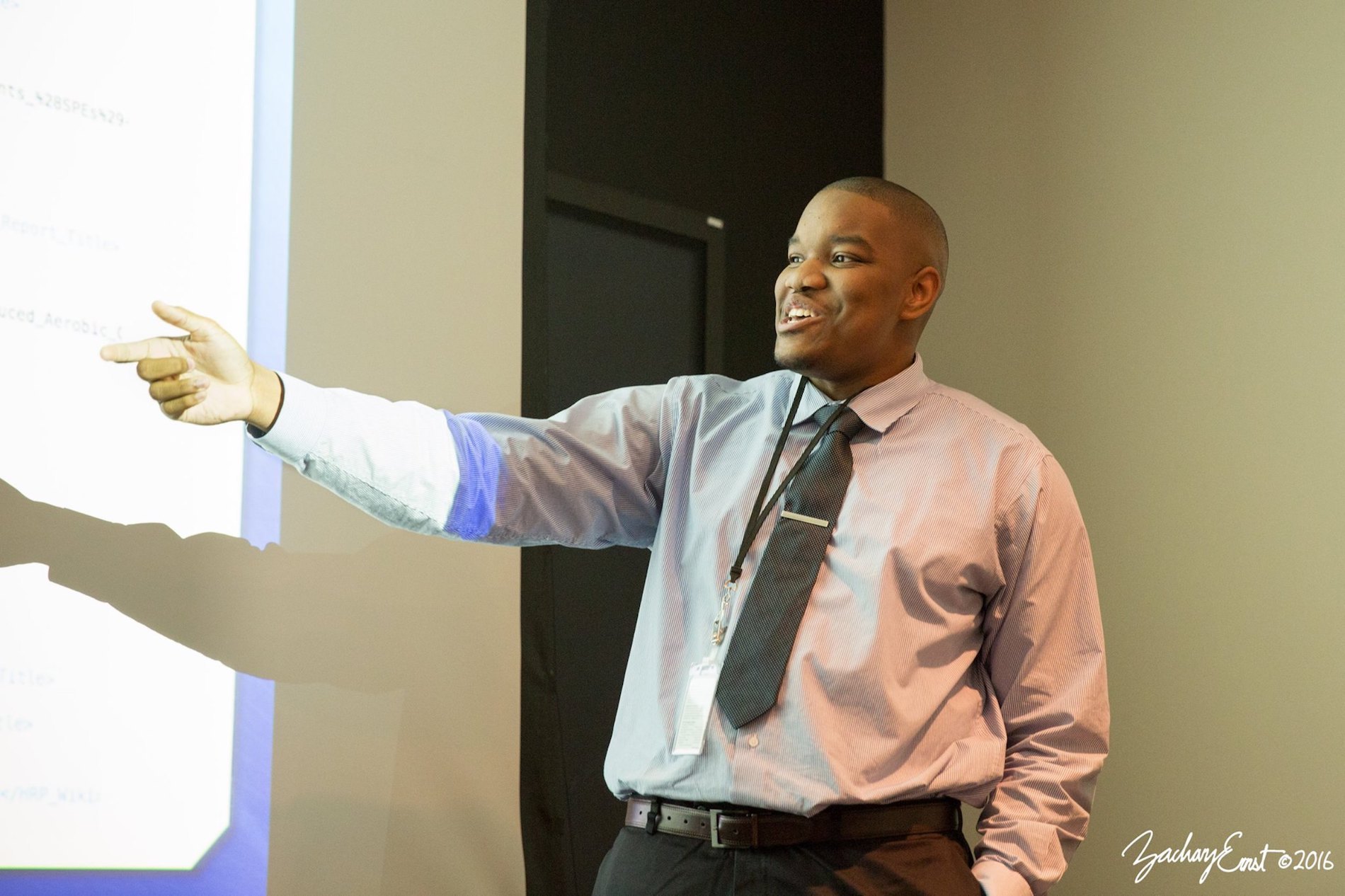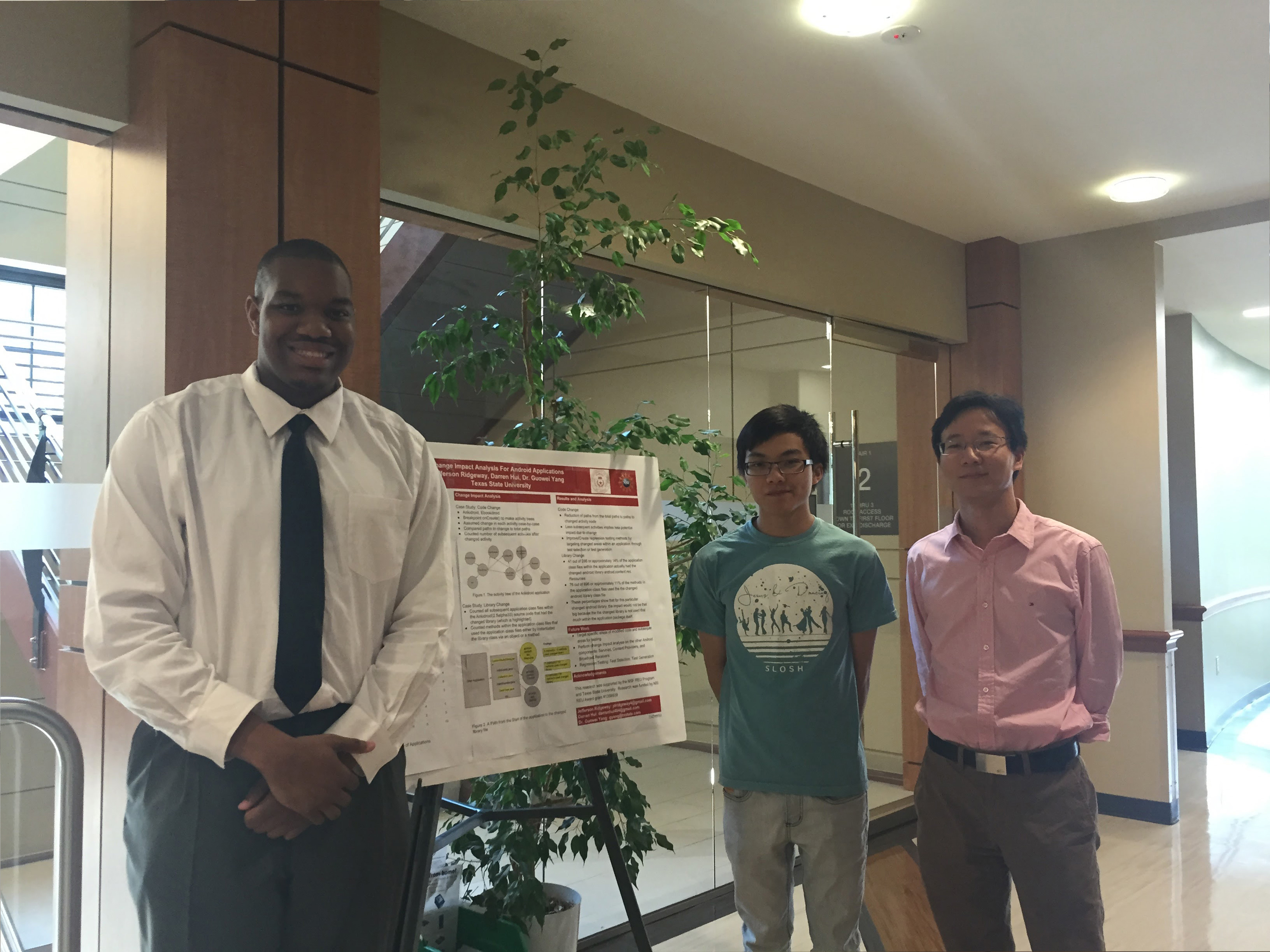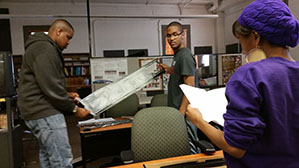

| Home | Resume | Professional Statement | Research | Links |
|---|
Enhancing Interactivity and engagements to the Science Gateway Community Institute Workforce Development Site
Team Members:Jefferson Ridgeway, Tatyana Matthews, Disaiah Bennett Spring 2017Mentors:Mr. Jeff Wood Keywords- SGCI, Science Gateways Community Institute, Bootstrap, HTML, CSS, JavaScript, WordPress, Liferay, widgets, components The Center of Excellence in Remote Sensing Education and Research (CERSER) on the campus of Elizabeth City State University is currently partnering with the San Diego Supercomputing Center and the Science Gateways Community Institute (SGCI). One of the five areas of SGCI is the Workforce Development led by Dr. Linda Hayden, the CERSER Principal Investigator. The Workforce Development aims to increase the development pipeline of young professionals and engage the potential of students from underrepresented groups. As science today grows increasingly computer based, it poses challenges and opportunities for researchers. Scientists and engineers are turning to gateways to allow them to analyze, share, and understand large volumes of data more effectively. The existence of science and engineering gateways and the sophisticated cyberinfrastructure (CI) tools together can significantly improve the productivity of researchers. Most importantly, science gateways can give uniform access to the cyberinfrastructure that enables cutting-edge science. The goal of the web development team was to increase the interactivity of the SGCI Young Professionals site to attract potential members and disseminate information. This was completed utilizing WordPress Widgets to provide graphical and interactive components. Bootstrap components (HTML, CSS, and JavaScript) were also researched for their inclusion into the current WordPress Content Management System (CMS) and the future Liferay CMS. (Extended Abstract)http://nia.ecsu.edu/ur/1617/teams/mmt/abstract.html Text Analytics of Selected Reports from the NASA Technical Reports
Team Member:Jefferson Ridgeway Summer 2016Mentors:Mrs. Manjula Ambur, Mr. Jeremy Yagle, Mr. Ted Sidehamer Keywords- XML, CSV, NTRS, WCA, NASA In recent years, powerful search tools like Google Scholar, Endnote, and Mendeley have provided students and scholars with immediate access to academic research and its metadata from different fields of study across the globe. Each of these tools and a myriad of others, allow users to input a search query and return the results from that query, while also allowing the user to save the search data as XML and/or CSV. Currently at NASA, NTRS (NASA Technical Report Server) works in the similar vein as the tools listed previously in that it houses scientific research documents from NASA Scientific and Technical Information (STI) Program. NTRS allows subject matter experts to search documents via a graphical user interface (GUI) online and see the immediate search query results and subsequent metadata in XML format. However, with the advancement of technologies and software tools, this method has now become inefficient in comparison of other tools that are currently within the industry. One of the recent tools being used in the past few years is IBM's Watson Content Analytics (WCA) software. This software, unlike more general search query tools, can provide key insights and patterns, identify trends and connections, and visualize networks of experts in a given domain. Therefore, it is much more powerful and efficient than the current software that is available. With this new acquired tool by NASA, this research project seeks to provide an efficient search tool for NASA subject matter experts (SME's) to use other than NTRS. This research project will focus on investigating and documenting the ingesting of a subset of selected reports from NTRS into the WCA tool for rapid processing. Design and Installation of a Video Conference Solution at the Center of Excellence in Remote Sensing Education and Research at Elizabeth City State UniversityTeam Members: Jefferson Ridgeway, Daquan Rascoe, Kevin Benton Spring 2016Mentor:Mr. Carlton Lamb Keywords- Networking, video conferencing, CERSER, ECSU During the 2016 Spring Semester, the Research Experience Undergraduates Networking team project identified, evaluated, and implemented a video conference solution. The main objective was to establish a fully functioning video conferencing solution in four locations: Dixon-Patterson Hall, Rooms 226, 232 and Lane Hall, Rooms 111 and 119. To understand and create the scope of work for the project, the team had to research/analyze the rigorous standards which are set in place by the International Telecommunications Union. This agency works directly under the authority of the United Nations and is charged with issues relating to information and communication technologies. The team examined the H.323 standard for Telemedicine, how Telemedicine has evolved, and how the H.323 standard has progressively changed the way we conduct our lives. After replicating the layout of the four spaces, the next objective was to identify and evaluate a software solution. After identifying and evaluating multiple video conferencing applications, the team selected a specific application. An example of an issue which eliminated one application was when an application indicated that a user would only have to open a link in the browser to be able to connect; but it did not indicate that the link would only work from within a certain browser. As for the hardware, the technical specifications of components were used to identify the hardware components. This method of selection, immediately gave preference to specific devices. The team also analyzed the history of video conferencing and how it has evolved. This research project enables the Center of Excellence in Remote Sensing Education and Research (CERSER) participants and invited guests to engage with others through video conferencing services. http://nia.ecsu.edu/ur/1516/teams/network/index.html Change-Impact Analysis For Android Applications
Team Members: Jefferson Ridgeway, Darren Hui Summer 2015Mentor:Dr. Guowei Yang Keywords- Android, regression testing, Android Library Android is a widely used mobile platform for which many applications are developed. During the development process, many modifications are made resulting in potential changes in old behaviors and the introduction of new behaviors. Therefore, ensuring the reliability of applications is highly desirable. However, traditional regression testing techniques cannot be directly applied to the Android domain due to its differing architecture. To better understand how to develop and improve upon regression testing techniques, we first conducted a bug study focusing on bugs related to change. Then, we performed a change impact analysis on selected applications to understand the potential effect changes in the Android library and in the Activity component could have on the rest of the application. We believe that this study will help developing new or improving upon existing regression testing techniques specific to the Android domain. Documentation of Site Preparation for Installation of SeaSpace Ground Stations at ECSU
Team Members: Jefferson Ridgeway, Tori Wilbon, Nigel Pugh Spring 2015Mentors: Andrew Brumfield, Michael Osterhouse Keywords- SeaSpace, TREX, TeraScan, CentOS, Visualization Stations, TeraVault, Monitoring Systems, GOES In September 2014, a transition was made to a direct purchase and installation of Seaspace hardware and software. The installation of the Seaspace hardware included: 15 Visualization stations, 2 monitoring systems, a Teravault raw storage device, and a TeraScan Rapid Environmental X-treme (TREX) high-powered processor. The installation of the Seaspace software on the 15 Visualization stations included: an updated version of TeraScan, which includes the Graphical User Interfaces TeraVision and TeraMaster, and CentOs, which is a Linux-based Operating System. Also two 5.0m L band systems were installed on Dixon-Patterson hall in the summer of 2012. The purpose of this project was to document the installation requirements and internal processes at ECSU for Seaspace Hardware and Software Equipment, with also addressing; the location of engineering findings, location of installation requirements, repositioning and securing current ground stations, and proper training center needs. http://nia.ecsu.edu/ur/1415/teams/terascan/Homepage.html A Project Management Framework for Cloud and HPC Resource ProvidersTeam Members: Jefferson Ridgeway, Ifeanyi Rowland Onyenweaku Summer 2014Project Leaders: Gregor von Laszewski, Fugang Wang Keywords- Cloudmesh, Project Management, User Management, Project Review Management, FutureGrid, MongoDB, Django Cloudmesh is a project that allows the management of virtual machines in a federated fashion. It can be run in two modes. One is a standalone mode where the users run cloudmesh on the local machines. The second mode is a hosted mode where multiple users share a web server through which the virtual machines are managed. One of the important functions for cloudmesh is to provide a sophisticated user management. This user management is currently conducted in drupal through the FutureGrid portal via an integration to the FutureGrid LDAP server. However, as the rest of cloudmesh is developed in python, the user management in FutureGrid has had some limitations. It is important to identify a python based solution with more advanced features in order to re-implement the user management functionality in cloudmesh to address long term sustainability of the user management component. https://github.com/cloudmesh/management Update of the CERSER TeraScan Cataloguing System TeraScan Image Processing Scripts
Mentor: Jeff Wood Keywords- GOES, TeraScan, ImageMagick, Macintosh OSX, MySQL, PHP, Remote Sensing The Center of Excellence in Remote Sensing Education and Research (CERSER) on the campus of Elizabeth City State University is currently tasked with the responsibility of receiving remotely sensed data from orbiting National Oceanic and Atmospheric Administration (NOAA) Polar Operational Environmental Satellites (POES) and the Geostationary Operational Environmental Satellites (GOES). This data is collected by SeaSpace TeraScan systems installed in the CERSER labs in Dixon-Patterson Hall. In 2005, the processing system underwent a major update due to a migration to a new operating system. A minor update was needed at this time to deal with a second operating system migration and display of the processed images on the CERSER web site. Since then, a second transfer to a new server was made in 2013. The cataloguing system went down at this time and was not repaired due to technical issues with the TeraScan system. The 2014 team corrected issues within the current server directory system and updated the data script to process images from the GOES-13 satellite received by the TeraScan system. Software and languages utilized for this task included ImageMagick, PHP, HTML, Dreamweaver, phpMyAdmin, and MySQL. Along with this operating system update, a major script development was needed on the TeraScan processing equipment due to an upgrade in hardware. The ground station upgrades included a 3.7m X/L band, a 3.6m C band, and a 5.0m L band dishes, along with accompanying computing hardware. This new script processes both infrared and visible light images received from the GOES-13 satellite into the Tagged Image File (TIFF) Format. |
||||
|
||||



